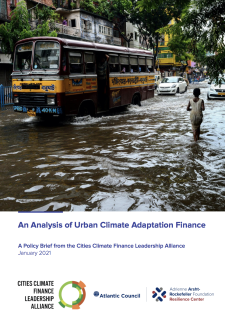
The Cities Climate Finance Leadership Alliance and the Atlantic Council’s Adrienne Arsht-Rockefeller Foundation Resilience Center released a brief, An Analysis of Urban Climate Adaptation Finance Tracking, that focuses on urban dwellers and aims to assess the volume and quality of finance that currently exists to address climate risk in cities. The analysis also outlines opportunities to increase and improve that finance. In assessing flows of adaptation finance to cities through 2018, they find that:
- Across sources tracked in the brief, less than USD 4 billion was invested annually in 2017-2018 in urban adaptation finance projects.
- The tracked finance is in contrast to World Bank’s estimate that between USD 11 and 20 billion will be needed by 2050 on an annual basis to protect global urban infrastructure from climate risks.
- In almost all regions, extreme heat and flooding/sea level rise were the most common hazards reported by city governments.
- Water and wastewater management projects addressing urban climate risk received the most finance of any sector, followed by disaster risk management.
Despite the significant gap between the assessed financing need to adequately address urban climate risk and tracked flows of finance, there are significant opportunities to increase finance for climate adaptation. These opportunities are discussed in more detail throughout the brief and include:
- Implementers can take best practices and lessons learned from successful financing already underway where innovative financial mechanisms have been employed to address climate risk in cities. This brief includes 12 examples of the use of financial instruments in the urban adaptation context spanning resilience bonds, disaster risk insurance pooling, public-private partnerships, and catastrophe bonds. We also recommend the development of a set of case studies that are accessible to a wide range of city implementers. The effort should also include a toolkit for cities seeking financing for adaptation projects.
- Cities and stakeholders should support government capacity building to implement urban adaptation activities. In order to improve the efficacy of finance to address urban climate risk, cities must rigorously assess their climate risks and should conduct physical climate scenario analysis. When the connection between financial flows and climate risk reduction can be substantiated with improved climate risk analysis, the accuracy of tracking adaptation finance in cities will also improve. Advanced tracking helps Development Finance Institutions (DFIs) and national and international policy makers target capital flows to locations with highest need, and allows for evaluation metrics to be established, thereby easing investor hesitancy.
This Urban Adaptation Finance Tracking brief identifies gaps and barriers to financing resilience solutions in global urban areas and highlights entry points to drive action by investors, cities, national governments, and other stakeholders to increase urban adaptation finance. The need to act now is greater than ever before as we chart a path to recovery from a global pandemic and prepare for a resilient future.
